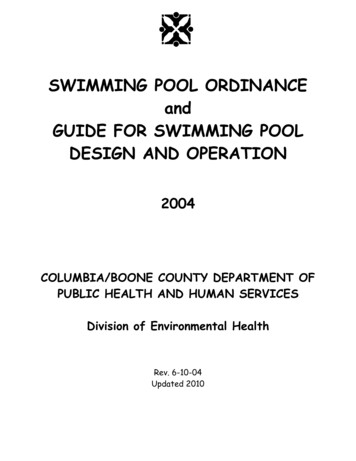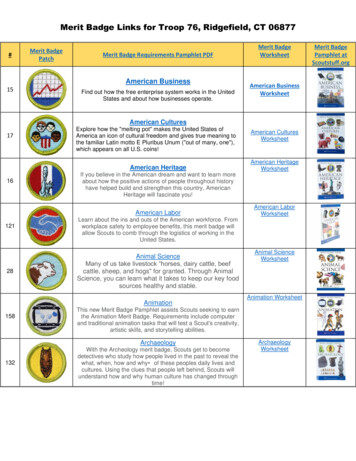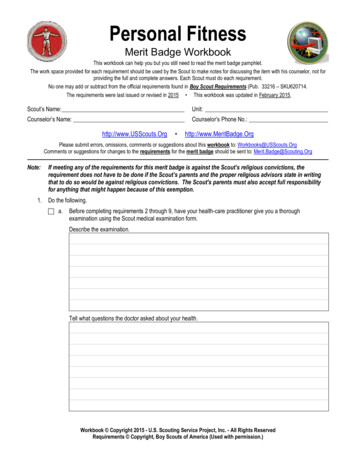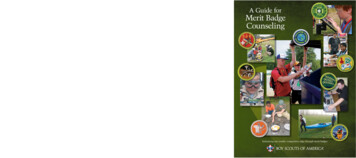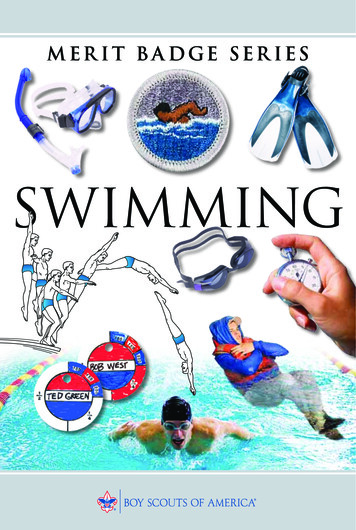
Transcription
SWIMMING
How to Use This PamphletThe secret to successfully earning a merit badge is for you to use boththe pamphlet and the suggestions of your counselor.Your counselor can be as important to you as a coach is to an athlete.Use all of the resources your counselor can make available to you.This may be the best chance you will have to learn about this particularsubject. Make it count.If you or your counselor feels that any information in this pamphlet isincorrect, please let us know. Please state your source of information.Merit badge pamphlets are reprinted annually and requirementsupdated regularly. Your suggestions for improvement are welcome.Send comments along with a brief statement about yourself to YouthDevelopment, S209 Boy Scouts of America 1325 West Walnut HillLane P.O. Box 152079 Irving, TX 75015-2079.Who Pays for This Pamphlet?This merit badge pamphlet is one in a series of more than 100 coveringall kinds of hobby and career subjects. It is made available for youto buy as a service of the national and local councils, Boy Scouts ofAmerica. The costs of the development, writing, and editing of themerit badge pamphlets are paid for by the Boy Scouts of America inorder to bring you the best book at a reasonable price.
BOY SCOUTS OF AMERICAMERIT BADGE SERIESswimming
Note to the CounselorLike other merit badges, the Swimming merit badge has beendeveloped to teach and train youth in a manner consistent withthe overall goals and values of the Boy Scouts of America. Themerit badge counselor should be fair and consistent and shouldpresent and teach the skills as presented in this pamphlet. Noneof the requirements should be omitted, and nothing should beadded to them.Candidates with an extensive swimming background maybe able to meet all or most of the requirements with little or noformal instruction from the counselor. Most Scouts, however,will need instruction prior to completing the requirements.Scouts may train as a single buddy pair or in small groups.Training sessions can be on a flexible schedule. Alternatively,larger groups may train together on a more formal basis atprearranged times. A counselor may also provide individualinstruction as long as there is another adult or youth present.Subject to equipment availability and other constraints, eachcandidate should have the opportunity to choose which of theoptional requirements he will complete. The “Aquatics” sectionof Camp Program and Property Management provides a suggested outline for Swimming merit badge instruction.The merit badge instruction should begin with a review ofrequirement 3. This will lay a suitable foundation for safety andfirst aid requirements 1 and 2. This review also will indicate individual levels of skill proficiency in various strokes, floating, andfeetfirst entry. Scouts should learn the leaping entry in the firstsession. The leaping entry, the preferred entry for the swim testsused in the Second and First Class rank requirements, shouldbe taught and emphasized in the first session as a safety skill tobe used throughout the class. The faceup float (requirement 6a)35957ISBN 978-0-8395-3352-8 2008 Boy Scouts of America2010 PrintingBANG/Brainerd, MN1-2010/059413
also should be taught in the First Class session as a confidencebuilder and as a resting and survival procedure for use duringthe class and beyond.Stroke instruction should begin in the first session andcontinue throughout the course. Base individualized instructionon the proficiency of each participant. Each participant maybe given the opportunity to complete the stroke requirement(requirement 5) when he appears ready.Regarding other requirements, Scouts should first master surface dives (requirement 7) before beginning snorkeling and scubadiving (requirement 8a). They should receive diving instruction(requirement 9) prior to competitive skills instruction (requirement 8b). Survival skills and knowledge (requirements 4, 6b, 6c,and 6d) can be covered at any time, because they relate closely tothe safety and preliminary skills in requirements 1 and 3.If Scouts complete requirement 10 concurrently with in-waterskills instruction, then the pertinent information should bepresented early enough in the course to allow time for Scoutsto study and prepare individual exercise program plans.Requirement 10c must be completed in writing. Requirements10a, 10b, and 10d may be done orally, but Scouts should notsimply listen to a presentation from the counselor. Each meritbadge candidate must learn the material and demonstrate thatknowledge by explaining the facts or concepts to his counselor.swimming3
Requirements1. Discuss the prevention of and treatment for health concernsthat could occur while swimming, including hypothermia,dehydration, sunburn, heat exhaustion, heatstroke, musclecramps, hyperventilation, spinal injury, stings and bites, andcuts and scrapes.2. Do the following:a. Identify the conditions that must exist before performingCPR on a person. Explain how to recognizesuch conditions.b. Demonstrate proper technique for performing CPR usinga training device approved by your counselor.3. Before doing the following requirements, successfullycomplete Second Class rank requirements 7a–7c andFirst Class rank requirements 9a–9c.Second Class rank requirements:(7a) Tell what precautions must be taken for a safe swim.(7b) Demonstrate your ability to jump feetfirst intowater over your head in depth, level off and swim25 feet on the surface, stop, turn sharply, resumeswimming, then return to your starting place.(7c) Demonstrate water rescue methods by reachingwith your arm or leg, by reaching with a suitableobject, and by throwing lines and objects. Explainwhy swimming rescues should not be attemptedwhen a reaching or throwing rescue is possible, andexplain why and how a rescue swimmer shouldavoid contact with the victim.4swimming
First Class rank requirements:(9a) Tell what precautions must be taken for asafe trip afloat.(9b) Before doing the following requirement,successfully complete the BSA swimmer test:Jump feetfirst into water over your head in depth,swim 75 yards in a strong manner using one or moreof the following strokes: sidestroke, breaststroke,trudgen, or crawl; then swim 25 yards using an easy,resting backstroke. The 100 yards must be swumcontinuously and include at least one sharp turn.After completing the swim, rest by floating.(9c) With a helper and a practice victim, showa line rescue both as tender and as rescuer.The practice victim should be approximately30 feet from shore in deep water.4. Demonstrate survival skills by jumping feetfirst into deepwater wearing clothes (shoes, socks, swim trunks, longpants, belt, and long-sleeved shirt). Remove shoes andsocks, inflate the shirt, and show that you can float usingthe shirt for support. Remove and inflate the pants. Swim50 feet using the inflated pants for support, then show howto reinflate the pants while still afloat.5. Swim continuously for 150 yards using the followingstrokes in good form and in a strong manner:front crawl or trudgen for 25 yards, backcrawl for 25 yards, sidestroke for 25 yards,breaststroke for 25 yards, and elementarybackstroke for 50 yards.6. Do the following:a. Float faceup in a resting position for atleast one minute.b. Demonstrate survival floating for at leastfive minutes.c. While wearing a properly fitted personalflotation device (PFD), demonstrate the HELPand huddle positions. Explain their purposes.d. Explain why swimming or survival floatingwill hasten the onset of hypothermia in cold water.swimming5
7. In water over your head, but not to exceed 10 feet, do each ofthe following:a. Use the feetfirst method of surface diving and bring anobject up from the bottom.b. Do a headfirst surface dive (pike or tuck), and bringthe object up again.c. Do a headfirst surface dive to a depth of at least 5 feetand swim underwater for three strokes. Come to thesurface, take a breath, and repeat the sequence twice.8. Do ONE of the following:a. Demonstrate snorkeling and scuba diving knowledge:(1) Demonstrate selection and fit of mask, snorkel, and fins; discuss safety in both pool andopen-water snorkeling.(2) Demonstrate proper use of mask, snorkel,and fins for underwater search and rescue.(3) Describe the sport of scuba diving or snorkeling, and demonstrate your knowledge of BSApolicies and procedures relating to that sport.ORb. Demonstrate the following competitive swimming skills:(1) Racing dive from a pool edge or dock edge(no elevated dives from racing platforms orstarting blocks)(2) Racing form for 25 yards on one competitive stroke(front crawl, back crawl, breaststroke, or butterfly)(3) Racing turns for the stroke that you chose in 8b(2),OR, if the camp facilities cannot accommodate theracing turn, repeat 8b(2) with an additional stroke.(4) Describe the sport of competitive swimming.
9. Following the guidelines set in the BSA Safe Swim Defense,in water at least 7 feet deep, show a standing headfirst divefrom a dock or pool deck. Show a long shallow dive, alsofrom the dock or pool deck.10. Do the following:a. Explain the health benefits of regular aerobic exercise,and explain why many people today do not get enoughof the beneficial kinds of exercise.b. Discuss why swimming is favored as both a fitness anda therapeutic exercise.c. Write a plan for a swimming exercise program that willpromote aerobic/vascular fitness, strength and muscletone, body flexibility, and weight control for a personof Scout age. Identify resources and facilities availablein your home community that would be needed forsuch a program.d. Discuss with your counselor the incentives and obstaclesfor staying with the fitness program you identified inrequirement 10c. Explain the unique benefits that couldbe gained from this program, and discuss how personalhealth awareness and self-discipline would relate to yourown willingness and ability to pursue such a program.swimming7
ContentsSafety. . . . . . . . . . . . . . . . . . . . . . . . . . . . . . . . . . . . . . . . . . 11Swimming Skills. . . . . . . . . . . . . . . . . . . . . . . . . . . . . . . . . . 29Swimming Strokes. . . . . . . . . . . . . . . . . . . . . . . . . . . . . . . . . 35Surface Dives . . . . . . . . . . . . . . . . . . . . . . . . . . . . . . . . . . . . 49Snorkeling and Scuba . . . . . . . . . . . . . . . . . . . . . . . . . . . . . . 53Diving. . . . . . . . . . . . . . . . . . . . . . . . . . . . . . . . . . . . . . . . . . 69Competitive Swimming. . . . . . . . . . . . . . . . . . . . . . . . . . . . . 75Swimming for Fitness and Health. . . . . . . . . . . . . . . . . . . . . . 91Swimming Resources. . . . . . . . . . . . . . . . . . . . . . . . . . . . . . . 95swimming9
.SafetySafetyDeveloped more than 60 years ago, the procedures included inthe Boy Scouts of America’s water safety plan have earnedScouting what is believed to be the most commendable watersafety record of any youth organization in the United States.BSA Safe Swim DefenseAll swimming activity in Scouting is conducted according toSafe Swim Defense standards. The eight points of Safe SwimDefense are as follows.1. Qualified SupervisionAll swimming activity must be supervised by amature and conscientious adult age 21 orolder who understands and knowinglyaccepts responsibility for the well-beingand safety of those in his or her care,and who is trained in and committedto compliance with the eight pointsof BSA Safe Swim Defense. It isstrongly recommended that all unitshave at least one adult or olderyouth member currently trained inBSA Swimming and Water Rescueor BSA Lifeguard to assist in theplanning and conduct of allswimming activities.swimming11
Safety.2. Personal Health ReviewA complete health history is required of all participants as evidence of fitness for swimming activities.Forms for minors must be signed by a parent orlegal guardian. Participants should be asked to relateany recent incidents of illness or injury just prior to theactivity. Supervision and protection should be adjusted toanticipate any potential risks associated with individualhealth conditions. For significant health conditions, theadult supervisor should require an examination by a physician and consult with the parent, guardian, or caregiverfor appropriate precautions.3. Safe AreaAll swimming areas must be carefully inspected and prepared for safety prior to each activity. Water depth, quality,temperature, movement, and clarity are important considerations. Hazards must be eliminated or isolated by conspicuous markings and discussed with participants.Controlled access. There must be safe areas for all participatingability groups to enter and leave the water. Swimming areas ofappropriate depth must be defined for each ability group. Theentire area must be within easy reach of designated rescuepersonnel. The area must be clear of boat traffic, surfing,or other nonswimming activities.Safe areas arebest inspected asa team so hazardscan be identifiedand removedif possible.12swimmingBottom conditions and depth: The bottom must be clear oftrees and debris. Abrupt changes in depth are not allowed inthe nonswimmer area. Isolated underwater hazards should bemarked with floats. Rescue personnel must be able to easilyreach the bottom. Maximum recommended water depth in clearwater is 12 feet. Maximum water depth in turbid water is 8 feet.
.SafetyVisibility. Underwater swimming and diving are prohibited inturbid water. Turbid water exists when a swimmer treadingwater cannot see his feet. Swimming at night is allowed onlyin areas with both surface and underwater lighting.Diving and elevated entry. Diving is permitted only into clear,unobstructed water from heights no greater than 40 inches.Water depth must be at least 7 feet for dives from fixed heightsup to 18 inches and at least 10 feet for dives from the side or adiving board for heights from 18 inches to 40 inches. Personsshould not jump into water from heights greater than they aretall, and only into water depths where impact with the bottomis absent or slight. No elevated entry is permitted where theperson must clear any obstacle, including land.Water temperature. Comfortable water temperature for swimming is near 80 degrees. Activity in water at 70 degrees or lessshould be of limited duration and closely monitored fornegative effects of chilling.Water quality. Bodies of stagnant, fetid water, areas with significant algae or foam, or areas polluted by livestock or waterfowlshould be avoided. Comply with any signs posted by local healthauthorities. Swimming is not allowed in pools with green, murky,or cloudy water.Moving water. Participants should be able to easily regain andmaintain their footing in currents or waves. Areas with largewaves, swiftly flowing currents, or moderate currents that flowtoward the open sea or into areas of danger should be avoided.Weather. Participants should be moved from the water to aposition of safety whenever lightning or thunder threatens.Wait at least 30 minutes after the last lightning flash or thunderbefore leaving shelter. Take precautions to prevent sunburn,dehydration, and hypothermia.PFD use. Swimming in clear water over 12 feet deep, in turbidwater over 8 feet deep, or in flowing water may be allowed if allparticipants wear properly fitted personal flotation devices andthe supervisor determines that swimming with PFDs is safeunder the circumstances.swimming13
Safety.4. Response Personnel (Lifeguards)Every swimming activity must be closely and continuouslymonitored by a trained rescue team on the alert for andready to respond during emergencies. Professionally trainedlifeguards satisfy this need when provided by a regulated facilityor tour operator. When lifeguards are not provided by others, theadult supervisor must assign at least two rescue personnel, withadditional numbers to maintain a ratio toparticipants of 1:10. The supervisor mustprovide instruction and rescue equipmentand assign areas of responsibility asoutlined in the BSA publication AquaticsSupervision. The qualified supervisor, thedesignated response personnel, and thelookout work together as a safety team.A simple emergency action plan shouldbe formulated by the safety team andshared with participants as appropriate.5. LookoutThe lookout continuously monitors the conduct of theswim, identifies any departures from Safe Swim Defenseguidelines, alerts response personnel as needed, andmonitors the weather and environment. The lookout should have a clear view of the entire areabut be close enough for easy verbalcommunication. The lookout musthave a sound understanding ofSafe Swim Defense but is notrequired to perform rescues.The adult supervisor mayserve simultaneously as thelookout but must assign thetask to someone else ifengaged in activities thatpreclude focused observation.14swimming
.Safety6. Ability GroupsAll youth and adult participants are designated as swimmers, beginners, or nonswimmers based on swimmingability confirmed by standardized BSA swim classificationtests. Each group is assigned a specific swimming area withdepths consistent with those abilities. The classification testsshould be renewed annually, preferably at the beginning ofthe season.Swimmers pass this test: Jump feetfirst into water over thehead in depth. Level off and swim 75 yards in a strong mannerusing one or more of the following strokes: sidestroke, breaststroke, trudgen, or crawl; then swim 25 yards using an easyresting backstroke. The 100 yards must be completed in oneswim without stops and must include at least one sharp turn.After completing the swim, rest by floating.Beginners pass this test: Jump feetfirst into water over thehead in depth, level off, and swim 25 feet on the surface. Stop,turn sharply, resume swimming, and return to the starting place.Anyone who has not completed either the beginner or swimmertests is classified as a nonswimmer.The nonswimmer area should be no more than waist tochest deep and should be enclosed by physical boundaries suchas the shore, a pier, or lines. The enclosed beginner area shouldcontain water of standing depth and may extend to depths justover the head. The swimmer area may be up to 12 feet in depthin clear water and should be defined by floats or other markers.swimming15
Safety.7. Buddy SystemEvery participant is paired withanother participant. Buddies staytogether, monitor each other, andalert the safety team if either needsassistance or is missing.Buddies check into and out ofthe area together. Buddies are normally in the same ability group andremain in their assigned area. If theyare not of the same ability group, thenthey swim in the area assigned to thebuddy with the lesser ability.Buddy checks indicate how closely the buddies are keepingtrack of each other. Roughly every 10 minutes, or as needed tokeep the buddies together, the lookout, or other person designated by the supervisor, gives an audible signal, such as a singlewhistle blast, and a call for “Buddies.” Buddies are expectedto raise each other’s hand before completion of a slow, audiblecount to 10. Buddies who take longer to find each other shouldbe reminded of their responsibility for each other’s safety.A buddy check also helps the safety team monitor everyonein the water. If a buddy is missing, a search is begun immediatelyin accordance with a prearranged emergency action plan. If everyone has a buddy, a count is made by area and compared withthe total number known to be in the water. Once the count isconfirmed, a signal is given to resume swimming.8. DisciplineRules are effective only when followed. All participantsshould know, understand, and respect the rules and procedures for safe swimming provided by Safe Swim Defenseguidelines. Applicable rules should be discussed prior tothe outing and reviewed for all participants at the water’sedge just before the swimming activity begins. People aremore likely to follow directions when they know the reasonsfor rules and procedures. Consistent, impartially applied rulessupported by skill and good judgment provide stepping-stonesto a safe, enjoyable outing.16swimming
.SafetyPool and Surf SwimmingSafe Swim Defense applies to swimming at a beach,private or public pool, wilderness pond, stream,lake, or anywhere Scouts swim. Here are someadditional points for the pool and the surf.Pool. If the swimming activity is in a publicfacility where others are using the pool atthe same time and the pool operator provides guard personnel, there may be noneed for additional Scout lifeguards andlookouts. However, there must always bean adult supervisor who understands his orher responsibility and ensures that the elements of Safe Swim Defense are followed. Thebuddy system is also critically important, evenin a public pool. Even in a crowd, you are alonewithout protection if no one is paying attention toyour circumstances.The rule that people swim only in water depths suitedto their ability also applies at pools. Most public pools divideshallow and deep water. This may be enough for definingappropriate swimming areas. If not, the supervisor shouldclearly point out to participants the appropriate areas of thepublic facility.Surf. The surf environment—with its wave action, currents,tides, backwash, and sea life such as stinging jellyfish—requiresprecautions for safe swimming that aren’t necessary in otherenvironments. A swimmer’s physical condition and skill arevery important and should enable the swimmer to recoverfooting in waves, swim for long periods without gettingworn out, and remain calm and in control when faced withunexpected conditions.Designated swimming areas are marked by flags or pennantsthat are easy to see. Beginners and nonswimmers should bepositioned inshore from standing lifeguards who are equippedwith rescue equipment. Better swimmers are permitted seawardof the lifeguards but must remain shoreward of anchored markerbuoys. The lifeguard-to-swimmer ratio should always be 1-to-10with a rescue team supplied with a rescue tube or other flotation aid stationed at the beach area.Unless your unitis experiencedin oceanswimming, itis probably bestto swim at abeach withprofessionallifeguards.swimming17
Safety.Rip CurrentsThe United States Lifesaving Association estimates that most rescues—about 80 percent—at surf beaches involve swimmers caught in rip currents.More than 100 swimmers die each year from this swimming hazard. Ripcurrents are long, narrow sections of water that form after waves break andthe water goes back out. Rip currents form a funnel of current that movesmuch faster than the current on either side. The current can be so strongthat it may be difficult or impossible to swim against it. It can carry anunsuspecting swimmer long distances from shore and even out to sea.Rip currents occur in oceans and any place where there are waves,including bodies of water such as the Great Lakes. To avoid getting caughtin a rip current, do not swim near piers or jetties (walls built out into thewater to protect a harbor or beach). Rip currents are often hard to see, butlook for the following clues: An area having a noticeable difference in water color A channel of churning, choppy water A line of foam, seaweed, or debris moving steadily away from shore A break in the incoming wave patternIf you are caught in a rip current, don’t fight it by swimming towardthe beach. Instead,turn and escape byswimming parallelto the shore. If thatdoesn’t work, float ortread water. Call orwave for help.wavesbeach18swimming
.SafetyFirst AidFollowing Safe Swim Defense will eliminate any serious risks inswimming, but remember to take proper precautions.Hypothermia occurs when the body’s core temperaturefalls below the normal range and the body cannot produceenough heat. Early signs include bluish lips and shivering.Further cooling will upset the victim’s ability to think clearlyand to do simple tasks. The person may appear groggy andlack coordination. As cooling continues, the pulse rate slowsand blood is directed to the critical organs and away from theextremities as the body attempts to prevent further heat loss.The heart and lungs keep working at the expense of the hands,feet, and brain. Further cooling will lead to unconsciousnessand even death.The first treatment for hypothermia is to prevent furtherheat loss. Once out of the water, the victim should not be allowedto walk. Move him to warmth and shelter such as a building,tent, or vehicle. As soon as possible, remove wet clothing andput on dry clothes or wrap the person in a blanket or dry towels. If the victim is unconscious, open the airway and check forbreathing. You may apply warm (but not hot) towels or itemssuch as hot water bottles wrapped in a towel to only the trunk,crotch, neck, and head. Do not rub his legs or apply warmingdevices to the arms or legs. These actions may cause more bloodto flow to the surface of the skin and away from vital organs.Finally, since even mild cases of hypothermia place the bodyin a highly stressed condition, closely watch all hypothermiavictims for several hours even if they appear to have recovered.Heat reactions, including heat exhaustion and heatstroke,result when the body can’t keep itself cool enough. Symptomsof heat exhaustion may include dizziness, faintness, nausea, anda severe lack of energy. A person also may develop a headache,muscle cramps, and rapid pulse; look pale; and be sweatingheavily. To treat heat exhaustion, have the victim lie down in aPrevent heatreactions bydrinking plentyof fluids andlimiting timeout in the openon hot days.Most sunburns are first-degree burns, but repeated sunburn over a longperiod of time can cause skin damage and increase the risk of skin cancer.It’s best to prevent sunburn by using plenty of sunscreen with a sun protection factor (SPF) rating of at least 15, or by wearing a hat and covering up.But if you have to treat a painful sunburn, use a cool, wet cloth and changeit frequently. Find shade.swimming19
Safety.If you have acramp whileswimming in deepwater and cannotswim to safety,float on your backor survival floatand wait for help.20swimmingcool, shady spot with the feet raised. Loosen clothing and coolhim with a damp cloth or a fan. Have him sip water. Recoveryshould be rapid. If the condition worsens, get medical help.Heatstroke is the extreme, life-threatening stage of a heatreaction in which dehydration (water loss) has caused a veryhigh body temperature. The victim’s cooling system has startedto fail, and the person’s core temperature is at a dangerouslyhigh level. In addition to any symptoms of heat exhaustion,heatstroke symptoms can include hot, sweaty, red skin, confusion, and disorientation; the victim may be unconscious. Thevictim must be cooled immediately. Loosen tight clothing, fanhim, and apply wet towels. If you have ice packs, wrap them ina thin barrier (such as a T-shirt) and place them under the armpits and against the neck and groin area. If the person is ableto drink, give small amounts of cool water. Treat for shock andseek emergency medical help.Muscle cramps, sometimes called muscle spasms, occurwhen muscles are not getting enough oxygen or nutrients orwhen the blood flow cannot prevent the build-up of wastesin muscles. Vigorous exercise and sweating can cause musclecramps in the limbs. Cold water or cold weather increases thelikelihood of cramping. Sudden, vigorous exercise without properwarm-up also can increase the risk of muscle cramps. If a musclebegins to cramp while you are swimming, get out of the waterand massage the cramp. If conditions are hot, cool down anddrink fluids. If conditions are cold, find warmth and cover. Rubthe cramping muscles to improve circulation.Sunburn is a familiar condition that can occur during swimming activities. Reflected sunlight from the water can be asdamaging as direct exposure. To prevent sunburn, cover up, usea waterproof sunscreen, and limit your time in the sun. If yourskin begins to redden or feel painful, get out of the sun. To treatsunburn, apply clean, wet compresses (cloths, towels, or gauzepads) dipped in cool water. Protect the burned area from furthersun exposure.Stings and bites are not a common hazard when swimming in pools or lakes, but in saltwater swimmers may suffersevere stings from certain types of jellyfish or other saltwatercreatures. Knowing the body of water you are swimming in andavoiding possible contact with dangerous sea animals is the beststrategy. For jellyfish stings, soak the area with vinegar or alcohol,or cover with a paste of baking soda mixed with water. Get medical help if the pain is severe; if the pain does not let up in a short
.Safetytime; or if the victim has an allergic reaction, feels dizzy, or hastrouble breathing. For typical insect stings and bites, apply basicfirst aid as described in the Boy Scout Handbook or the First Aidmerit badge pamphlet.Cuts and scrapes may occur on the feet when swimmingin natural waters if the bottom has not been carefully checkedfor hazards. In pool swimming, such injuries are more likelywhen climbing in and out of the water without being carefulalong rough edges or corners. As in other situations, the woundshould be cleaned, disinfected, and covered. The patrol first-aidkit should contain appropriate supplies for minor woundtreatment. For severe bleeding injuries, control bleeding withdirect pressure or at pressure points until emergency medicalhelp arrives.Spinal injuries can occur from diving into shallow orobstructed water. Rescuers must be very careful when a spinalinjury is suspected. Spinal injuries can be fatal or can causeparalysis. If the victim is not handled properly, additional serious injury could result. Moving a victim is an extremely delicatetask best left to trained emergency personnel, but if no one elseis present you may need to act. In a swimming accident, youmay h
merit badge counselor should be fair and consistent and should . Discuss why swimming is favored as both a fitness and a therapeutic exercise. c. Write a plan for a swimming exercise program that will promote aerobic/vascular fitness, strength and

